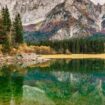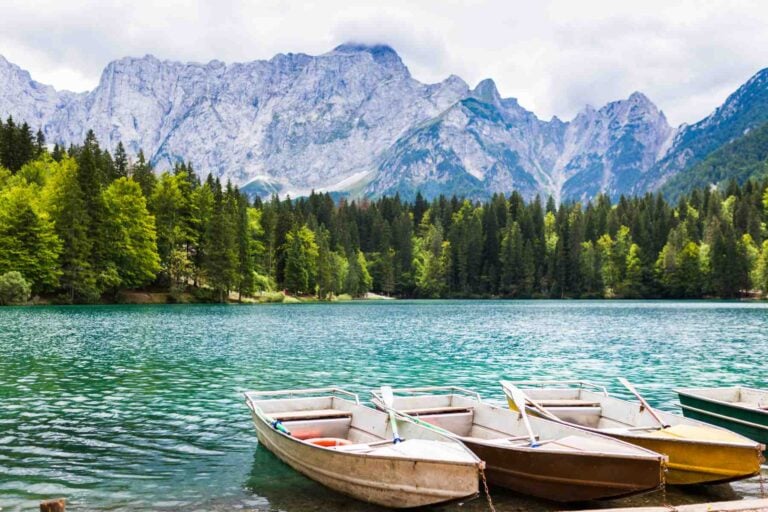
We are reader-supported and may earn a commission on purchases made through links in this article.
When I first saw Laghi di Fusine in my friend’s photos, it was love at first sight (which is difficult given how many different places we see on social media every day). However, the beautiful Fusine Lakes, as they are called in English, are anything but ordinary.
It’s an Italian jaw-dropping destination with two crystal-clear lakes that reflect the dense pine forest, the sky, and Mount Mangart. The reflections truly seem to be works of art.
Best Tips & Tools to Plan Your Trip
Laghi di Fusine is located in Europe, in northern Italy’s Friuli-Venezia-Giulia region. It is in the province of Udine, in the heart of the Julian Alps, a mountain range that separates Italy and Slovenia.
Don’t worry if the only Italian word you know is espresso; you’ll be fine in English as well. By the way, the official currency for that espresso is the euro.
It’s interesting to note that the Fusine Lakes are about a 35-minute drive from Austrian Villach, an hour from Ljubljana, and only 15-20 minutes from Slovenian Kranjska Gora. Yet, so many people don’t know about this hidden gem.
So, before you tell your friends, here are some travel tips.
Laghi di Fusine, Belopeška Jezera, or Weissenfelser Seen?
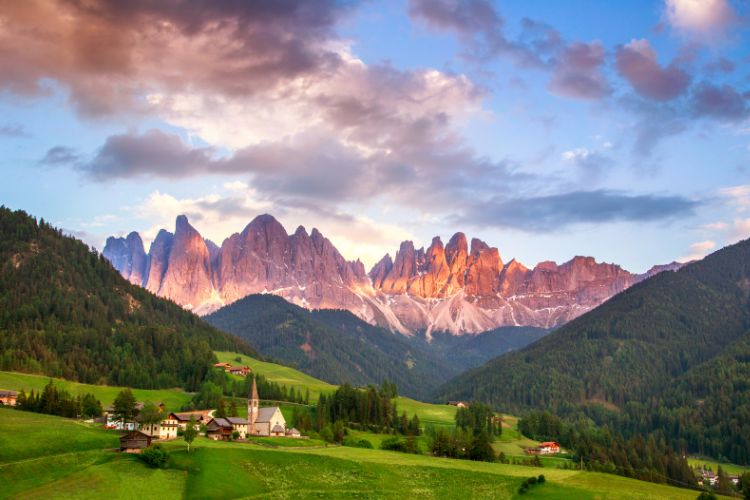
Italy designated the Fusine Lakes as a national park in 1971. Laghi di Fusine contains two glacial lakes, Upper Lake (Lago Superiore) and Lower Lake (Lago Inferiore), which are only 6.5 kilometers from the Slovenian border and 15 kilometers from Austria’s border.
So, despite the fact that the Austrians travel to the Weissenfelser Seen (in German), the Slovenians to the Belopeška Jezera (in Slovenian), and you to the Laghi di Fusine (in Italian), you are all actually traveling to the same location.
Lago Inferiore (the Lower Lake)
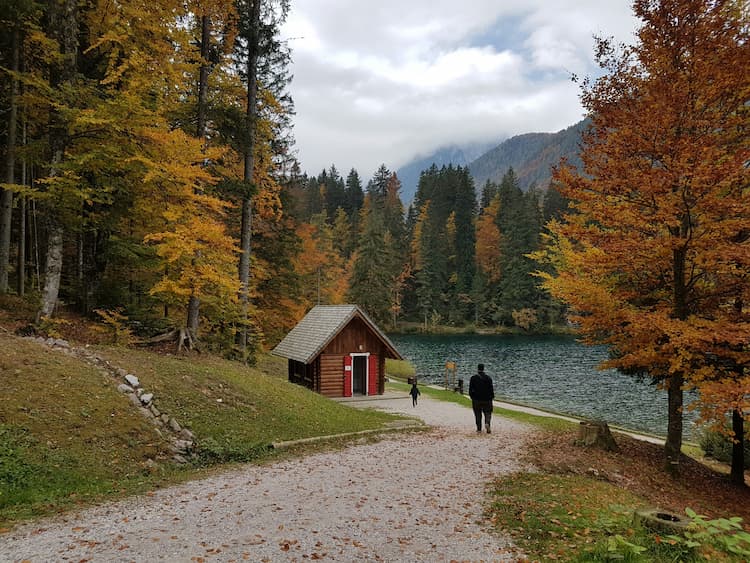
Lago di Fusine Inferiore (the Lower Lake) gets its stunning emerald color from the reflection of the surrounding dense pine forest. It is 924 meters above sea level, covers 13.5 hectares, and has an average depth of 25 meters.
While on Lago Inferiore, you can rent a wooden boat or SUP, swim, and relax on the well-maintained beaches. You can also eat or drink at the restaurant Belvedere, which is well-known for its terrace that overlooks the lake. Or, if you are really hungry, go to the Edelweiss.
Of course, the best free activity is to walk along the path that leads through the forest to various viewpoints.
I believe you will never need more time in your life to cover 1,7 kilometers; every few steps, you simply have to stop and admire the scenery. Which is fantastic because, honestly, when was the last time you spent a day admiring something?
How to Connect the Fusine Lakes
The Fusine lakes are connected by paths, and the entire route is 4.2 kilometers.
Of course, you will need much longer than the approximate 1.5 hours that you would normally need. Although some claim that two hours is enough time for this location, I believe it would be a shame to stay for only that long.
Lago Superiore (the Upper Lake)
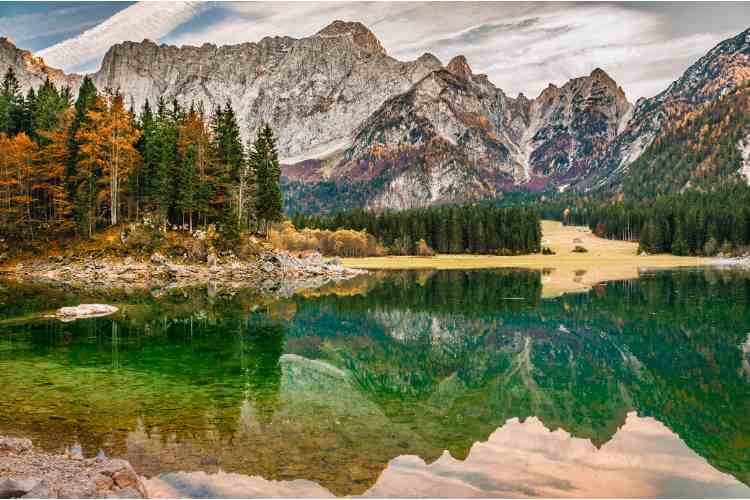
Many people (including myself) consider Lago Superiore superior to Lago Inferiore not only in terms of height but also beauty. This is because of the Mangart Mountain massif, which produces even more beautiful scenery in this area.
Lago di Fusine Superiore is 929 meters above sea level, covers 9 hectares, and has a maximum depth of approximately 10 meters.
Along with the typical tourist attractions—coffee shops, restaurants, and wooden benches for relaxing and enjoying—you will also come across hiking trails.
Not Enough Walking? Time for Rifugio Luigi Zacchi
For hikers who are looking for not-so-basic activities, take the Rifugio Luigi Zacchi route. Its starting point is the Upper Lake, and it is open from May to September and December to Easter.
If you enjoy cycling, there is also a 4.5-kilometer-wide macadam MTB trail.
Whatever option you select, the reward is the same: a breathtaking view and a connection with nature. Of course, treating yourself to a warm meal in a mountain hut will complete your reward.
Where to Park at Laghi di Fusine
If you enjoy hiking, that’s great; if not, don’t worry: Laghi di Fusine has 400 parking lots right next to Lago di Fusine Superiore. It just got even more perfect, right?
Keep in mind that this is a protected area, so motor vehicles will be charged a 3 euro entrance fee for motorcycles and 5 euro for cars.
If you don’t want to pay, park near the entrance and go for a 20-minute walk, which will be a great warm-up for the walks around the Fusine Lakes.
And if you arrive on foot or by bike, you will be rewarded with free entry. Cool, right?
Winter Idyll or Summer Colors: When Should You Visit Laghi di Fusine?
Of course, July and August are the busiest months on the Laghi di Fusine, and these are the ideal months for refreshment (the summertime water temperature can reach 20 degrees).
If you want to enjoy the beauty of Laghi di Fusine without the crowds, go in May or September. The fall season is also an excellent one.
During winter, the Fusine Lakes are likely frozen, and the surrounding forests and mountain massifs are covered in snow. It sounds ideal, but there’s one less-than-ideal detail: the wintertime temperatures here are among the lowest in the region.
Whatever time of year you choose, visit the Fusine Lakes early in the morning: it’s more peaceful, there are fewer tourists, and, if photography is important to you, the lighting is better (since the lakes are shaded during the afternoon). And don’t we all agree that there is a certain magic to the mornings? I mean, there isn’t a shortage of magic here anyway.
Dolomites, Tarvisio, and More: What Else to Do?
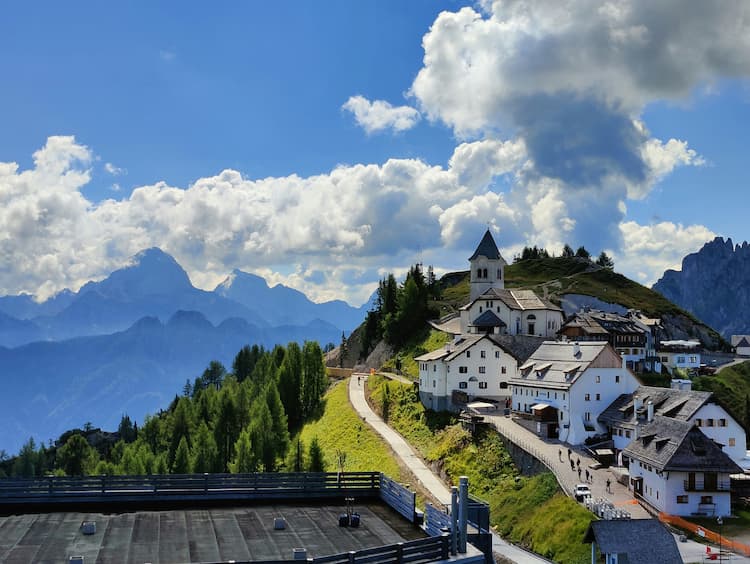
While you’re in this well-kept Italian secret, think about going to the Monte Lussari shrine and the well-known ski resort nearby.
Only 20 minutes away from the Fusine Lakes is another beautiful Italian lake, Lago del Predil, with an adorable little island that appears to float on the emerald lake.
You can also consider the breathtaking Dolomites, whose beauty deserves its own article.
If you have time, take a day trip to Slovenia. Or, even better, take a few days. If you do so, don’t miss the breathtaking Lake Jasna, which is accessible via the Vršič pass, Slovenia’s highest mountain pass at 1611 meters above sea level.
Visit beautiful Lake Bled, which I recently wrote about, or the breathtaking Triglav National Park. Ski enthusiasts should visit Planica, the cradle of ski jumping and a Slovenian winter sports center. If you just can’t get enough of the turquoise color, visit the Valley of the Soča River.
If you are pressed for time, end your trip to the Fusine Lakes with a visit to Tarvisio. It’s only 10 kilometers away, with narrow streets and traditional houses at 754 meters above sea level.
Tarvisio offers a variety of restaurants, allowing you to avoid waiting in lakeside restaurants, save money, and visit another great destination. It’s a good deal, isn’t it?
Laghi di Fusine & Children?
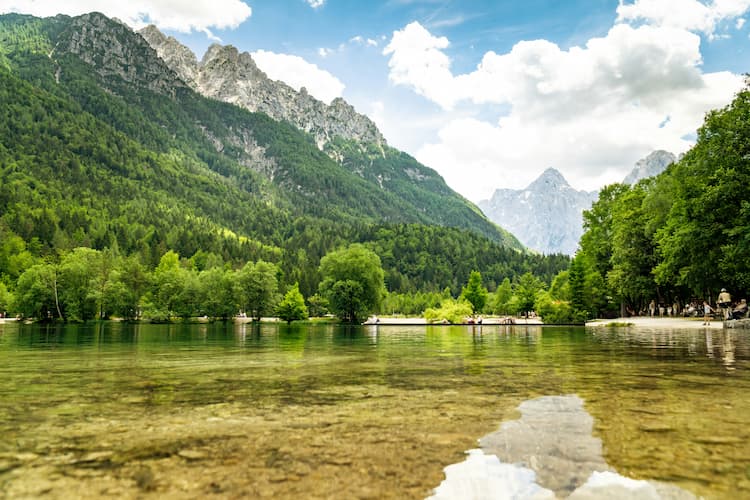
The parking lot is right next to the Lago di Fusine Superiore, and the walking paths around the Fusine Lakes are very easy. So yes, Laghi di Fusine is a great destination for families with children.
If you want to completely delight your children (and get them to eat all the vegetables at lunch for the next few weeks), take them to Tarvislandia, a nearby snow amusement park, which is 12 kilometers away. Don’t worry, it’s open during the summer too.
Laghi di Fusine Mystery
The discovery of a beautiful girl’s dead body in Lake Fusine Superiore in 2007 shocked the locals. Detective investigations have revealed that the people of northern Italy keep darker secrets than we might imagine.
Don’t worry, this is just the plot for the film La Ragazza del Lago, which was shot on Laghi di Fusine.
Even though the movie received mixed reviews, many viewers came away from it wondering two things: first, where are these amazing lakes, and second, how did I never know about them before?
So, before too many people discover this Italian hidden gem, visit Laghi di Fusine and admire nature’s incredible work of art.
Inspire your next adventure with our articles below:

